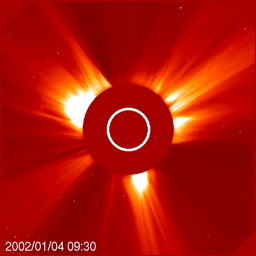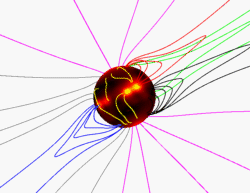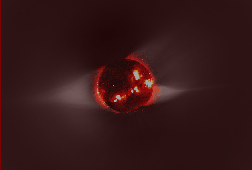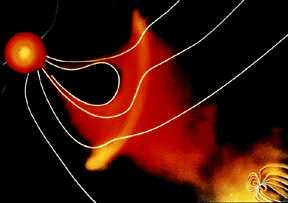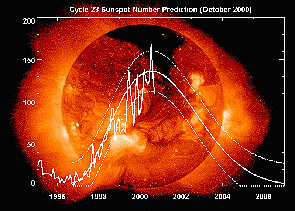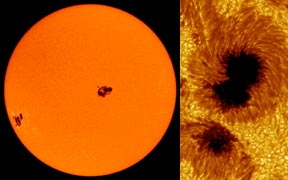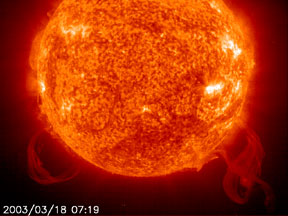Click on image for full size
Images courtesy SOHO (NASA & ESA). Animation by Windows to the Universe staff (Randy Russell).
Related links:
Movie: A Computer Model of a CME - from the Sun to Earth
Movie: Journey Beneath a Sunspot
Movie: Geomagnetic Substorm Triggered by CME from Sun
A movie of a coronal mass ejection in white light, courtesy of the High Altitude Observatory (180K MPEG) Movie credit
Coronal Mass Ejections
"Without warning, the relatively calm solar atmosphere can be torn asunder by sudden outbursts of a scale unknown on Earth. Catastrophic events of incredible energy...stretch up to halfway across the visible solar surface, suddenly and unpredictably open up and expel their contents, defying the Sun's enormous gravity." (Sun, Earth, and Sky by Kenneth R. Lang)These catastrophic events that the author is speaking about are coronal mass ejections (CME's).
Coronal mass ejections are explosions in the Sun's corona that spew out solar particles. The CME's typically disrupt helmet streamers in the solar corona. As much as 1x10^13 (10,000,000,000,000) kilograms of material can be ejected into the solar wind. Coronal mass ejections propagate out in the solar wind, where they may encounter the Earth and influence geomagnetic activity.
CME's are believed to be driven by energy release from the solar magnetic field. How this energy release occurs, and the relationship between different types of solar activity, is one of the many puzzles facing solar physicists today.
CME's can seriously disrupt the Earth's environment. Intense radiation from the Sun, which arrives only 8 minutes after being released, can alter the Earth's outer atmosphere, disrupting long-distance radio communications and deteriorating satellite orbits. Very energetic particles pushed along by the shock wave of the CME can endanger astronauts or fry satellite electronics. These energetic particles arrive at the Earth (or Moon) about an hour later. The actual coronal mass ejection arrives at the Earth one to four days after the initial eruption, resulting in strong geomagnetic storms, aurorae and electrical power blackouts. All of these solar-terrestrial interactions are forecasted and monitored by the those who work in the space weather area.
Coronal mass ejections will become more and more frequent as we near solar maximum. CME's, not discovered until the 1970's, are difficult to detect. That is why we need satellites such as the ACE satellite which acts as a spaceweather station while in orbit. ACE can provide a one-hour advance warning of any geomagnetic storms that would affect the Earth.
"Thus, the Sun's sudden and unexpected outbursts remain as unpredictable as most human passions. They just keep on happening, and even seem to be necessary to purge the Sun of pent-up frustration and to relieve it of twisted, contorted magnetism." (Kenneth R. Lang, Sun, Earth and Sky)


